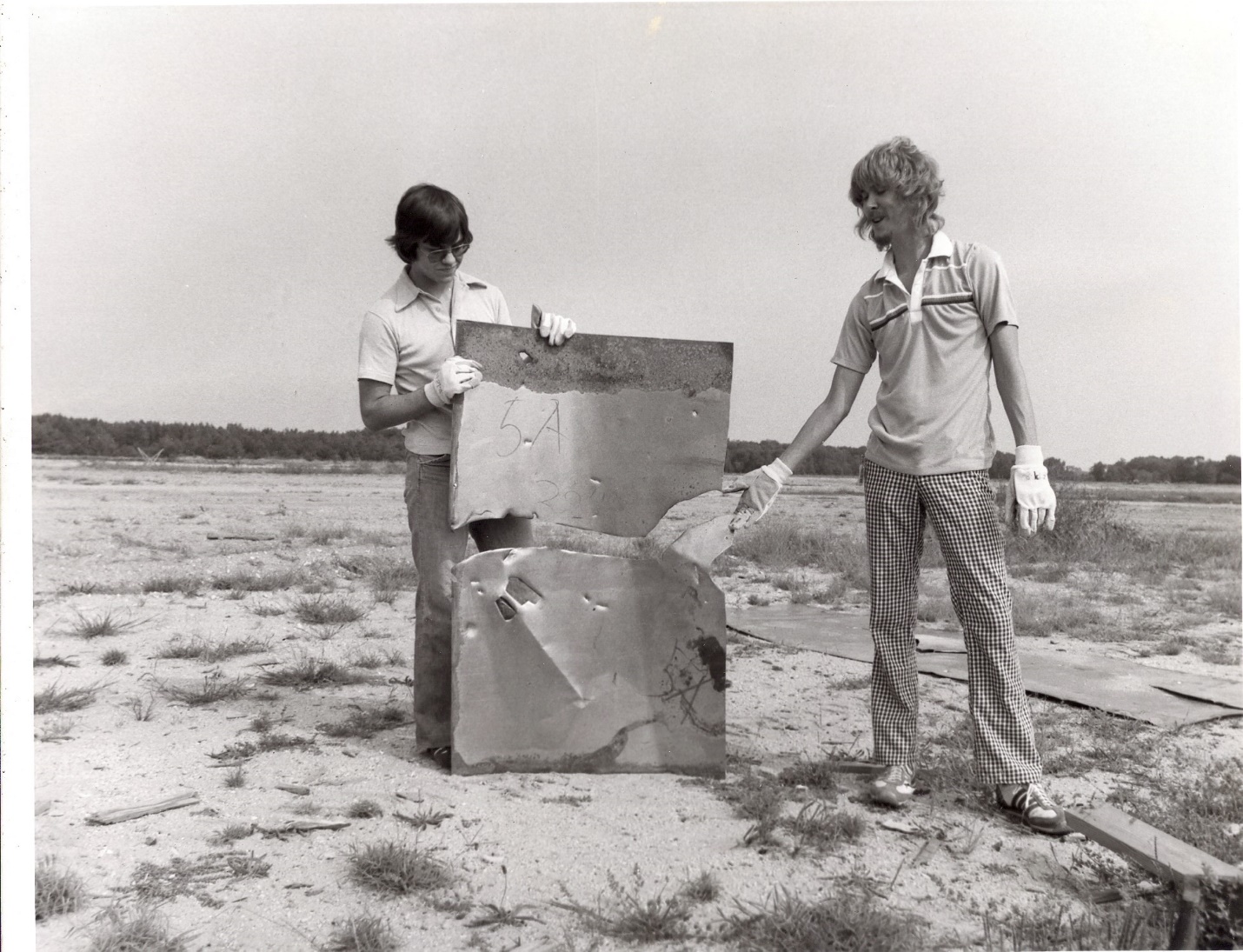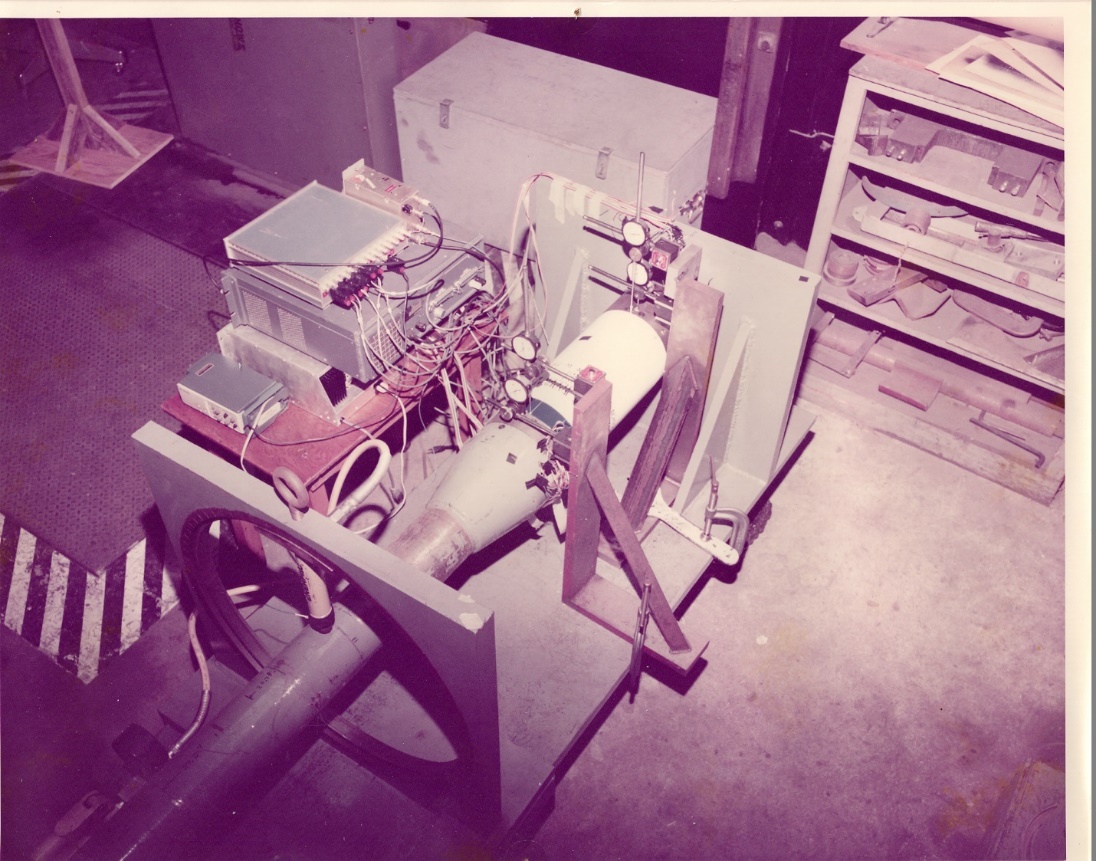Explosive Facilities and Forgotten Projects
By Charles R. Garnett
Special Guest Writer
I started work at Dahlgren in the summer of 1978, just after high school. I was hired by Clyde Johnson, Warheads Branch Head, as an engineering co-op. Alternating work in the summer and winter was the ideal way to put myself though college. Clyde knew I was poor, and he brought me in to work over holidays and breaks. It wasn’t until years later when I became a branch head that I realized the paperwork he endured to give my bank account an extra week of work.
That first summer I took measurements in the field (Figure 1, that’s me on the left), bent inert warheads at the shell house (Figure 2) and learned to program the new HP 9845 desktop computer (mostly just programing the plotting of data). During later co-op rotations (working for Bill Elliott), I wrote software to analyze data from Flash X-Ray testing. This test used medical x-ray film and large (1 million electron volt) x-ray pulsars to capture fragments in flight (Figure 3). Working with national experts like Sam Waggener taught me how warheads performed.
Al Hales was working to create new warhead concepts for the Advanced Standard Missile (SM) (ASM—an overworked acronym). Like any new initiative, money is tight until things get off the ground. Co-ops were cheap, and Al employed me twice to help create warhead concepts. This work turned out to be start of the Mk 125 Warhead Program. Many of the early (1986) Warheads Branch team is shown in Figure 4.
By the mid-1980s, Bill Elliott had completed Mk 115 SM warhead development, and was assembling the team for the next-generation Mk 125 warhead. I became the lead engineer, working with a senior technician named Bill Henderson. Henderson and I had worked together on the Sea Sparrow warhead, and he had a true talent for manufacturing design. If there was a way to build it, Bill would find it. In 1987 Henderson and I received a patent for the Mk 125 design (Figures 5 and 6). Bob Dibble joined our team as the test engineer and spent the latter part of the 1980s at the Pumpkin Neck Explosive facility. His job was to get the warhead through fleet qualification and safety testing. Figure 7 shows this core team in 1988.
The Mk 125 warhead has been in fleet service since 1991. It was recently selected for a new version of the Standard Missile, the SM-6, ensuring fleet service for another decade or two. Those early days of my career were amazing, and many talented people taught me how to be an engineer and weapons designer.
Projects wind down and, by 1990, the Mk 125 was out of qualification and heading into production.
In 1990, I was looking to move to another warhead development effort when an unexpected opportunity arrived. The Warheads Branch ran a small explosive test facility called “Rocket Lab.” This facility was once used to burn small restrained rockets. It hadn’t done that kind of work since the 50s, but names change slowly at Dahlgren. There were six skilled technicians that operated two Flash X-Ray facilities, an industrial X-Ray facility for ordnance inspection and a million-frame-per-second Cordin camera for filming explosive detonations.
The team lead was a savvy old-school technician named Travis Shelton. Travis was retiring after 41 years of service, and the Branch Head (Walter Hoye) asked if I would be interested in running the facility. The people on the team I was inheriting were artists at explosive testing. To give you an example of their skills, when I went to Hewlett-Packard in Oregon to learn about Flash X-Ray photography, Travis was one of the instructors hired by HP (class photo in Figure 8). Some of my fondest memories were Travis’ last few weeks showing me the myriad of labs and buildings and equipment he had squirreled away. At one point, we are in the Dahlgren boneyard (old pieces of steel and armor and fixtures). He kept pointing to things labeled “AH” in white paint and saying, “That’s yours; that’s yours.”
I finally asked what AH stood for (thinking it was an armor acronym). He turned and said, “Adolph Hitler…. If I put TS on it, they’d know it was mine and steal it.” One thing is certain; everyone I met in those early days knew who Travis Shelton was.
Travis and I went to the Montana shelter—a full-scale test facility. Up to 50 lbs. of high explosive could be placed in barbettes (tubes cut from old battleships). These steel cylinders were 5 ft. in diameter, 8 feet tall, and 6-inch-thick armor. We cut a slit, and when you blew the warhead, only a small slice of fragments would exit. These tubes were so strong they barely swelled, and lasted for hundreds of shots. As we circled the facility, Travis pointed out a large 8 ft. diameter barbette off to the side, one I’d never used or even noticed before. A 3-inch thick steel plate was leaning on the edge, like the top of an old country well. Now, only a piece of plywood was covering the top … and it was sagging. “What is that?” I asked.
“Don’t know for sure, some old test rig. Problem is, it’s slightly radioactive inside, hence the covers. The base is cleaning up all the old Phalanx DU (depleted uranium, used in the Phalanx Gun System) contaminated sites, but this predates that … so they’re not sure what do with it. Until they identify what it is, it’s all yours.”
My team consisted of five technicians—Harry Donovan, Russ Marders, Hobert Southall, Benny Simpson, and Billy Bowler—and one young engineer, George Clotfelter. I know warhead performance, lethality and modeling, but operating the equipment is an art these technicians had honed over years. In the midst of all the high-tech equipment, some of the more mundane things would surprise you. For example, we were conducting a torpedo warhead test at Montana shelter. This was a fairly good sized bomb, in a barbette, another steel wall protecting the instrumentation, and a steel and concrete wall behind that protecting us. Nevertheless, the explosion can be felt. As we get ready for the countdown we all plug our ears and bend our knees a little and I notice all the crew glance upward. Why? Well, sometimes snakes got in the bunker and when the bomb went off, they fell. Most were just black snakes, but best not to be under one. Fieldwork is seldom the way it’s presented in college.
This was a fun time for me, even with the periodic trouble about cleanup of the radioactive barbette. Still of unknown origin.
Life is full of circles. In 1991, I was getting into woodworking at home. We had just bought our first house and I had a small room for a shop. Mr. Stone, a neighbor of my wife when she was growing up, was a restorer of antiques. He had a small shop in a backyard building. I went to him to discuss what my first purchases should be for my shop. ‘Old Man Stone’ was a wealth of info and we chatted for hours. When he found out I worked explosive testing at Dahlgren he asked if I ever did any work at Montana shelter. “Sure, all the time.”
“Is the old barbette still there?” (long pause) “Do you know what it is?”
He proceeded to tell me it was part of project Elsie (we’re talking around 1948), the nuclear projectile. The barbette was used to test explosives on materials. Not the nuclear fuel, but radioactive nonetheless. It was his job to don the rubber suit and clean things up; then the suit and material were disposed of. Two things came of this chance meeting: I purchased my first table saw, and I gave enough info to the cleanup crew that the barbette could be disposed of.

Figure 1. Fieldwork at Pumpkin Neck (left, Charles Garnett; right, Rocky [?], hold a steel plate cut in half by a continuous rod warhead.

Figure 2. First mechanical project: bending inert warheads at the shell house. Note the dial indicator gauges and large instrument box for only a few strain gauges and one pressure gauge.

Figure 3. Fragments captured in flight by X-ray photography

Figure 4. 1986 Warhead Branch Awards: Bill Holt, Russ Marders, Aubrey Jennings, Sam Waggener, Dan Poppen, Eric Bosworth, Bill Grigsby, Christine Mason, Hobert Southall, Travis Shelton, Benny Simpson, Bill Mock, Harry Donovan, Tom Swierk, Charles Garnett, Bill Henderson.

Figure 5. 1987 Warhead Invention Award: Charles Garnett (left) receives the award from Branch Head Walter Hoye.

Figure 6. 1987 Patent Award for Charles Garnett (middle left and Bill Henderson (middle right). On the left is Walter Hoye, Warheads Branch Head. On the right is Charlie Cooper, Missile Systems Division Head.

Figure 7. 1988 SM Warhead Team: Bill Elliott, Charles Garnett, Bob Dibble, Bill Henderson

Figure 8. 1991 Flash X-ray Class, Oregon. Back row: Travis Shelton, Charles Garnett (fourth and fifth from left), and George Clotfelter (fourth from right).